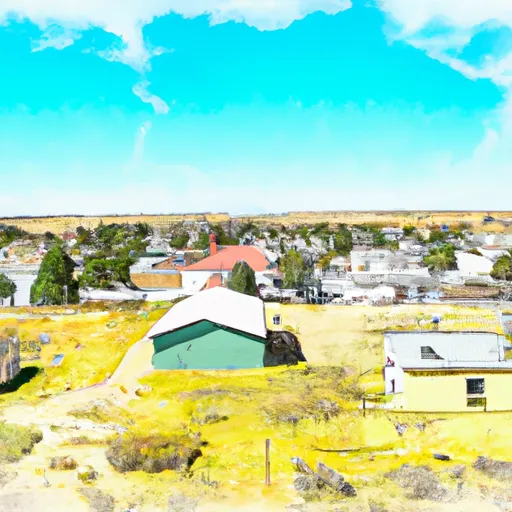-
 Snoflo Premium
Snoflo Premium
Get unlimited access to all our content
With no Ad interruptions! - Start Your Free Trial Login with existing account
Kinnear
Eden Index
Climate
6.7
•
Recreation
1.8
•
Community
•
Safeguard
3.3/10

Kinnear is a small town located in Fremont County, Wyoming. The climate in Kinnear is characterized by cold winters and warm summers. The average temperature in January, the coldest month, is around 20°F (-6°C), while in July, the warmest month, temperatures can reach up to 90°F (32°C). Precipitation is relatively low throughout the year, with an average of 10 inches (25 cm) annually, and snowfall is common in the winter months.
Kinnear benefits from its proximity to the Wind River, which contributes to the town's hydrology constituents. The Wind River is a source of water for various outdoor recreational activities in the area. Fishing enthusiasts can enjoy angling for trout, such as rainbow, brown, and cutthroat, as well as other species. The river is also suitable for boating and kayaking, providing opportunities for water-based adventures.
Additionally, Kinnear is surrounded by picturesque landscapes, making it an ideal location for hiking, camping, and wildlife observation. The nearby Shoshone National Forest offers numerous trails for exploration, allowing visitors to immerse themselves in the natural beauty of the area. Overall, Kinnear provides ample opportunities for outdoor enthusiasts to enjoy a variety of recreational activities in a stunning Wyoming setting.
What is the Eden Index?
The Snoflo Eden Index serves as a comprehensive rating system for regions, evaluating their desirability through a holistic assessment of climate health, outdoor recreation opportunities, and natural disaster risk, acknowledging the profound impact of these factors on livability and well-being.
Climate Health Indicator (CHI): 6.7
Kinnear receives approximately
251mm of rain per year,
with humidity levels near 72%
and air temperatures averaging around
7°C.
Kinnear has a plant hardyness factor of
4, meaning
plants and agriculture in this region thrive during a short period during spring and early summer. Most
plants will die off during the colder winter months.
By considering the ideal temperature range, reliable water supplies, clean air, and stable seasonal rain or snowpacks, the Climate Health Indicator (CHI) underscores the significance of a healthy climate as the foundation for quality living.
A healthy climate is paramount for ensuring a high quality of life and livability in a region, fostering both physical well-being and environmental harmony. This can be characterized by ideal temperatures, reliable access to water supplies, clean air, and consistent seasonal rain or snowpacks.
Weather Forecast
Streamflow Conditions
Big Horn
Area Rivers
Big Horn
Snowpack Depths
Big Horn
Reservoir Storage Capacity
Big Horn
Groundwater Levels
Recreational Opportunity Index (ROI): 1.8
The Recreational Opportunity Index (ROI) recognizes the value of outdoor recreational options, such as parks, hiking trails, camping sites, and fishing spots, while acknowledging that climate plays a pivotal role in ensuring the comfort and consistency of these experiences.
Access to outdoor recreational opportunities, encompassing activities such as parks, hiking, camping, and fishing, is crucial for overall well-being, and the climate plays a pivotal role in enabling and enhancing these experiences, ensuring that individuals can engage in nature-based activities comfortably and consistently.
Camping Areas
| Campground | Campsites | Reservations | Toilets | Showers | Elevation |
|---|---|---|---|---|---|
| Atlantic City | 16 | 8,106 ft | |||
| Worthen Meadows | 28 | 8,841 ft | |||
| Fiddlers Lake | 20 | 9,417 ft | |||
| Sinks Canyon State Park | 30 | 6,475 ft | |||
| Big Atlantic Gulch | 10 | 8,043 ft | |||
| Louis Lake | 9 | 8,577 ft | |||
| Sinks Canyon | 14 | 6,891 ft | |||
| Dickinson Creek | 15 | 9,360 ft | |||
| Little Popo Agie | 4 | 8,786 ft | |||
| Lander City Park | 20 | 5,400 ft |
Nearby Fishing
Catastrophe Safeguard Index (CSI):
The Catastrophe Safeguard Index (CSI) recognizes that natural disaster risk, encompassing floods, fires, hurricanes, and tornadoes, can drastically affect safety and the overall appeal of an area.
The level of natural disaster risk in a region significantly affects safety and the overall livability, with climate change amplifying these risks by potentially increasing the frequency and intensity of events like floods, fires, hurricanes, and tornadoes, thereby posing substantial challenges to community resilience and well-being.
Community Resilience Indicator (CRI):
The Community Resilience Indicator (CRI) recognizes that education, healthcare, and socioeconomics are crucial to the well-being of a region. The CRI acknowledges the profound impact of these elements on residents' overall quality of life. By evaluating educational resources, healthcare accessibility, and economic inclusivity, the index captures the essential aspects that contribute to a thriving community, fostering resident satisfaction, equity, and social cohesion.

